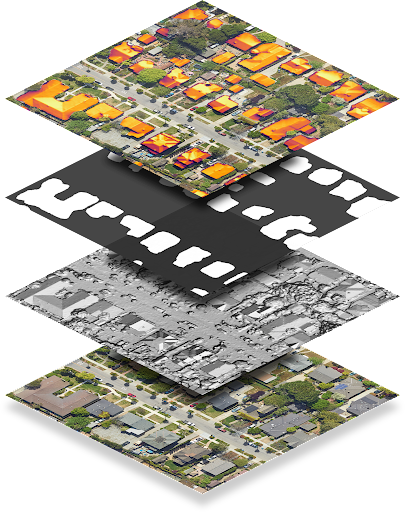
Конечная точка dataLayers возвращает данные, закодированные в виде файлов GeoTIFF, которые можно использовать в любом приложении географической информационной системы (ГИС) для проектирования солнечных систем.
Каждая строка в ответе dataLayers содержит URL-адрес, который можно использовать для получения соответствующего файла GeoTIFF. URL-адреса действительны в течение часа после их создания из исходного запроса на слои данных. Файлы GeoTIFF могут храниться до 30 дней.
За исключением RGB-слоя, файлы GeoTIFF некорректно отображаются в программах просмотра изображений, поскольку представляют собой закодированные данные, а не RGB-изображения. Файлы GeoTIFF также нельзя использовать напрямую в качестве накладываемого изображения с помощью Maps Javascript API.
В следующей таблице подробно описан каждый слой.
| Слой | Глубина пикселя | Разрешение | Описание |
|---|---|---|---|
| Цифровая модель поверхности (DSM) | 32-битное число с плавающей точкой | 0,1 м/пиксель | Данные о высоте, отражающие рельеф земной поверхности, включая природные и архитектурные объекты. Значения указаны в метрах над уровнем моря. Недействительные местоположения или области, по которым у нас нет данных, сохраняются как -9999. |
| РГБ | 8-битный | 0,1 м/пиксель 0,25 м/пиксель | Аэрофотоснимок или спутниковый снимок региона. Файл изображения GeoTIFF содержит три канала, соответствующие значениям красного, зелёного и синего, для формирования 24-битного RGB-значения для каждого пикселя. По умолчанию разрешение пикселей составляет 0,1 м/пиксель. |
| Строительная маска | 1-бит | 0,1 м/пиксель | Один бит на пиксель указывает, считается ли этот пиксель частью крыши. |
| Годовой поток | 32-битное число с плавающей точкой | 0,1 м/пиксель | Карта годового потока солнечной энергии, падающей на крыши, в регионе. Значения указаны в кВт·ч/кВт/год. Поток рассчитывается для каждой локации, а не только для крыш зданий. Недействительные локации или области, где нам не удалось рассчитать поток, сохраняются как -9999. Локации за пределами нашей зоны покрытия недействительны. Примечание: это немаскированный флюс. |
| Ежемесячный поток | 32-битное число с плавающей точкой | 0,5 м/пиксель | Карта месячного потока солнечного света (солнечного света на крышах домов, с разбивкой по месяцам) в регионе. Значения указаны в кВт·ч/кВт/год. Файл изображения GeoTIFF содержит 12 каналов, соответствующих периоду с января по декабрь (по порядку). |
| Почасовая тень | 32-битное целое число | 1 м/пиксель | 12 URL-адресов для почасовых карт теней, соответствующих периоду с января по декабрь, по порядку. Каждый файл GeoTIFF содержит 24 полосы, соответствующие 24 часам суток. Каждый пиксель — это 32-битное целое число, соответствующее (максимум) 31 дню месяца. 1 бит означает, что в соответствующем месте солнце видно в этот день, в этот час, в этот месяц. Недействительные местоположения сохраняются как -9999 и имеют установленный бит 31, поскольку он соответствует 32-му дню месяца и, следовательно, недействителен. |
Декодирование почасовых растров теней
Почасовые данные о затенении кодируются в многополосных растрах. Подробнее об основах работы с растрами см. в разделе «Концепции Solar API» .
При запросе почасовых данных о тенях вы можете получить до 12 растров, по одному на каждый месяц календарного года (с января по декабрь). Каждый растр состоит из 24 слоёв, или полос , соответствующих 24 часам суток.
Каждая полоса представлена матрицей ячеек, или пикселей . Каждый пиксель имеет глубину 32 бита, что соответствует (максимум) 31 дню месяца. Таким образом, для декодирования данных о дне, времени и месяце цветового диапазона требуется понимание анализируемого бита, полосы и растра.
Например, чтобы определить, было ли в заданной точке с координатами (x, y) солнце в 16:00 22 июня, выполните следующие действия:
- Сделайте запрос слоев данных для всех слоев для местоположения (x, y).
- Поскольку июнь — шестой месяц года, извлеките шестой URL-адрес из списка
hourlyShadeUrls. - Почасовые диапазоны представлены в 24-часовом формате. Чтобы получить данные за 16:00 (16:00), выберите 17-й канал.
- Индекс битов (дней) от 0. Чтобы получить данные за 22 июня, прочитайте бит 21.
- Биты предоставляют двоичные данные, указывающие, было ли в данном месте солнце в указанную дату и время. Если бит равен 1, то в данном месте было солнце. Если бит равен 0, то в данном месте была тень.
Следующий код суммирует вышеописанные шаги:
(hourly_shade[month - 1])(x, y)[hour] & (1 << (day - 1))

